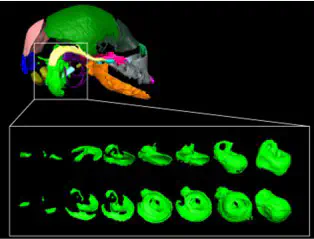Prenatal cranial bone development of Thomas's horseshoe bat (Rhinolophus thomasi): with special reference to petrosal morphology

Abstract
Cochlear morphology has been regarded as one of the key traits to understand the origin and evolution of echolocation in bats, given its functionality and performance for receiving echolocation sonar. While numerous researchers have compared adult-stage morphology, few have studied the prenatal development of the cochlea. Here, we provide the first detailed three-dimensional description of the prenatal cranial development in bats, using Rhinolophus thomasi as a model, with particular interest to the petrosal which houses the cochlea. Results revealed that among all cranial bones the onset of the ossification of the petrosal is earlier in R. thomasi when compared to other reported mammals. Generally, the cochlea reaches adult size and shape before or around birth in placental mammals including bats, but we found that its shape and size growths continue until maturity in Rhinolophus species. The relationship of cochlear size and skull size is maintained constant throughout the postnatal ontogeny to adulthood in Rhinolophus, a pattern previously reported neither in any other bats nor other mammals. The peculiar developmental pattern in Rhinolophus possibly allows them to form their characteristically large cochlea and facilitate their distinctive echolocation behavior. A recent study reported that non-echolocating Pteropodidae shares a similar prenatal cochlear size to laryngeal echolocating bats. The apparent resemblance of fetal cochlear size was proposed to be a vestigial signal of large cochlear size in the last common ancestor of bats and thus as supporting evidence for the single origin of laryngeal echolocation. However, results from the present observations suggest that limited aspects of the cochlear development were captured in this previous investigation and that the resulting interpretations may be questionable. We point out that diversity and patterns of cochlear development among bats are still not resolved, and the controversy on the origins of laryngeal echolocation is still open to discussion.
Nojiri, T., Werneburg, I. Son, N. T., Tu, V. T., Sasaki, T., Maekawa, Y., and Koyabu, D.
Journal of Morphology (2018)